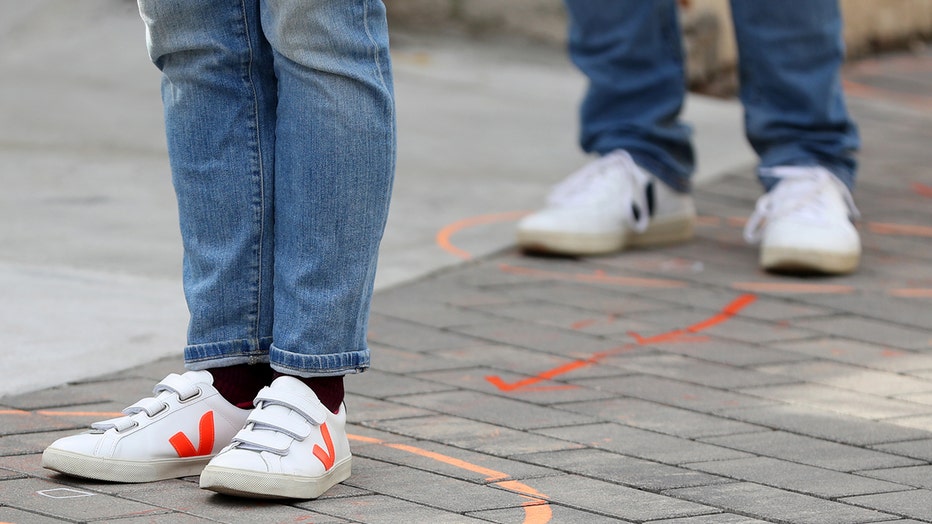Survey: Widespread decline in social distancing preceded COVID-19 surge in US
LOS ANGELES - Social distancing has decreased dramatically since the spring, and the states that largely haven’t adhered to staying six feet apart and wearing masks are being hit the hardest by COVID-19 surges, according to a large survey.
Researchers polled 139,230 individuals across all 50 states between April and November 2020 and found a general decline in social distancing over the summer and into the fall.
For example, the percentage of people saying they have been in a room with people who are not members of their own household in the preceding 24 hours jumped from 26% in April to 45% in October.
RELATED: US COVID-19 deaths top 3,100 in single day, hospitalizations reach record 100K
Large group activities have particularly jumped in frequency. Reports of people being in groups of 11 to 100 or more in the preceding 24 hours more than doubled, from 2.4% of respondents in April to 6.4% in October.
The findings also suggested that states that had the lowest levels of social distancing behavior and mask wearing are currently suffering the worst outbreaks.

Shoppers stand at a distance at the Safe Supply outdoor grocery store at Bow Market on March 21, 2020 in Somerville, Massachusetts. In order to comply with the city of Somerville's food safety protocol and social distancing recommendations, patrons r
“Perhaps the most interesting, and alarming, statistic is the strong, inverse correlation between a state’s score on our social distancing index and the prevalence of COVID in the state. In other words, where social distancing is lower, COVID prevalence is higher,” Matthew Baum, a co-author of the survey, told FOX TV Stations. “We find a similarly (slightly less strong, but still very strong) correlation when we focus on mask wearing. These are exceptionally high correlations.”
The survey used a scale derived from eight questions, normalized into a 0-100 scale, where maximum social distancing behavior earned a score of 100 and minimum behavior earned a score of zero.
For example, Wyoming’s social distancing index ranked in last place with 66.77 points in the spring, compared to only 32.7 points in the fall.
RELATED: Overwhelmed hospitals scramble for help amid pandemic
On Nov. 30, Wyoming reported a record high of 247 coronavirus hospitalizations as Gov. Mark Gordon was experiencing mild symptoms of COVID-19. Gordon tested positive on Nov. 25.
Generally, the subpopulations in the survey with higher levels of social distancing were women, Asian Americans and African Americans, as well as older, more educated, and Democratic people.
Younger respondents started out with moderately lower levels of social distancing than older respondents, but have dropped far more, from 78 in April to 31 in October; by comparison, the oldest cohort dropped from 97 to 74.
While social distancing did decrease throughout the pandemic, it’s important to note that mask wearing increased among the 50 states. But researchers found the growing partisan chasm in social distancing and mask wearing to be striking.
The survey found that partisan gaps in behavior were very large and have increased — especially for social distancing — over the past six months.“Democrats and Republicans have both trended in the same direction — increased mask wearing and decreased social distancing during this period,” the survey authors wrote. “However, Democrats have increased mask wearing faster than Republicans, and decreased social distancing slower.”
In April, there was a five percentage point partisan gap on the social distancing index, and by November, the gap was 23 points.
“In the current period, politics permeates everything, including public health. The remarkable resilience of partisan tribalism in the face of seemingly ever rising illness and death is both striking and, I think, in many ways defines the American response to the pandemic,” Baum said.
RELATED: Unemployment claims remain high at 712,000 as COVID-19 pandemic escalates
This survey comes as the U.S. Centers for Disease Control and Prevention announced new alternatives to its two-week recommended quarantine period. The CDC’s 14-day guidance was reduced to 10 days without a COVID-19 test if the individual has not reported any symptoms or after seven days with a negative COVID-19 test and no reported symptoms.
The news also comes as cases and hospitalizations surge across the country. The U.S. recorded more than 3,100 COVID-19 deaths in a single day, obliterating the record set last spring.
Meanwhile, the number of Americans hospitalized with the virus has surpassed 100,000 for the first time and new cases are topping 200,000 a day, according to figures released Thursday.
“Human beings are by nature social creatures. Asking them to isolate for a limited period of time is difficult, but doable; asking them to do so, without slippage, over an extended, undefined period is much harder and this difficulty has to some extent facilitated the resurgence of the virus this fall,” Baum said.
Baum said he and other researchers hope to continue further surveys to understand the myriad issues surrounding vaccinating an entire population in record time — ranging from vaccine hesitance, to possible premature relaxation of social distancing behaviors, to the potential politics surrounding the distribution of vaccines.

